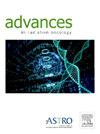Monitoring of Early Skin Reactions by Optical Coherence Tomography and Dermatoscopy in Patients Receiving Radiation Therapy for Head and Neck Cancer
IF 2.7
Q3 ONCOLOGY
引用次数: 0
Abstract
Purpose
Patients with head and neck cancer undergoing radiation therapy (RT) may experience pronounced acute skin reactions. We tested whether optical coherence tomography (OCT) and dermatoscopy could detect and monitor early subclinical RT-induced skin changes and might be used as a noninvasive prediction tool for higher-grade acute toxicity.
Methods and Materials
Handheld OCT and dermatoscopy were used to monitor skin conditions during RT in head and neck cancer patients. Images were reviewed for typical and suspicious features facilitated by electronic image analyses. Radiation toxicity was graded weekly by a radiation oncologist. Machine learning was used to analyze the recorded data and to extract features, patterns/anomalies, and risk prediction values for high-grade radiation toxicity.
Results
The most common skin features during RT observed by OCT were expressions of hyperkeratosis, blister formation, and in selected cases, formation of extensive microvascular structures or stratification disorder. Dermatoscopy revealed an almost linear increase in skin redness and saturation over the course of RT. By integrating all imaging and clinical data from RT weeks 1 to 3, it was possible to predict an increased risk of severe radiation toxicity (National Cancer Institute Common Terminology Criteria for Adverse Events (CTCAE) grade 3 or higher) in the second half of RT. A prediction accuracy of 72%, 75%, and 77% was achieved with OCT and clinical assessment, dermatoscopy and clinical assessment, and all 3 modes combined, respectively.
Conclusions
OCT and dermatoscopy can detect early radiation-induced skin changes at a subclinical level. Dermatoscopy is more accessible, whereas OCT requires training and further electronic processing to interpret images. Dermatoscopy, but not OCT, can quantify skin color changes, whereas OCT is able to deliver unique information on epidermal suspicious microstructural changes.
光学相干断层扫描和皮肤镜对头颈癌放疗患者早期皮肤反应的监测
目的头颈癌患者接受放射治疗(RT)可能会出现明显的急性皮肤反应。我们测试了光学相干断层扫描(OCT)和皮肤镜检查是否可以检测和监测早期亚临床rt诱导的皮肤变化,并可能作为高级别急性毒性的无创预测工具。方法与材料采用手持式OCT和皮肤镜监测头颈癌患者放疗期间的皮肤状况。通过电子图像分析,对图像进行了典型和可疑特征的审查。放射肿瘤学家每周对辐射毒性进行分级。机器学习用于分析记录的数据,并提取特征、模式/异常和高级别辐射毒性的风险预测值。结果在RT期间,OCT观察到最常见的皮肤特征是角化过度、水疱形成的表达,并在少数病例中形成广泛的微血管结构或分层障碍。皮肤镜检查显示,在整个放疗过程中,皮肤红肿和饱和度几乎呈线性增加。通过整合放疗第1周至第3周的所有影像学和临床数据,可以预测在放疗后半段发生严重辐射毒性的风险增加(美国国家癌症研究所不良事件通用术语标准(CTCAE) 3级或更高)。通过OCT和临床评估、皮肤镜检查和临床评估,预测准确率分别为72%、75%和77%。以及这三种模式的组合。结论soct和皮肤镜检查可在亚临床水平发现早期辐射引起的皮肤变化。皮肤镜检查更容易获得,而OCT需要训练和进一步的电子处理来解释图像。皮肤镜检查,而不是OCT,可以量化皮肤颜色的变化,而OCT能够提供表皮可疑微观结构变化的独特信息。
本文章由计算机程序翻译,如有差异,请以英文原文为准。
求助全文
约1分钟内获得全文
求助全文
来源期刊

Advances in Radiation Oncology
Medicine-Radiology, Nuclear Medicine and Imaging
CiteScore
4.60
自引率
4.30%
发文量
208
审稿时长
98 days
期刊介绍:
The purpose of Advances is to provide information for clinicians who use radiation therapy by publishing: Clinical trial reports and reanalyses. Basic science original reports. Manuscripts examining health services research, comparative and cost effectiveness research, and systematic reviews. Case reports documenting unusual problems and solutions. High quality multi and single institutional series, as well as other novel retrospective hypothesis generating series. Timely critical reviews on important topics in radiation oncology, such as side effects. Articles reporting the natural history of disease and patterns of failure, particularly as they relate to treatment volume delineation. Articles on safety and quality in radiation therapy. Essays on clinical experience. Articles on practice transformation in radiation oncology, in particular: Aspects of health policy that may impact the future practice of radiation oncology. How information technology, such as data analytics and systems innovations, will change radiation oncology practice. Articles on imaging as they relate to radiation therapy treatment.
 求助内容:
求助内容: 应助结果提醒方式:
应助结果提醒方式:


